CO2 Emission Analysis for Different Types of Electric Vehicles When Charged from Floating Solar Photovoltaic Systems
Abstract
1. Introduction
- (a)
- Floating system: The floating system is a combination of structure and floater. The PV system is mounted on top of the floating system.
- (b)
- Mooring system: A mooring system is any structure to which a vessel may be anchored using cables or anchors. Mooring prevents FSPVS components from spinning or floating away.
- (c)
- PV system: A PV system consists of PV modules and other power conditioning equipment for converting solar energy to electrical energy. In general, crystalline solar PV modules are utilized, although there is ongoing research into the type of PV modules installed in FSPVS. Sahu et al. [10] recently conducted an energy analysis of thin-film PV technology on land, water, and submerged systems, demonstrating the advantages of submerged installations.
1.1. Contribution
- Design a floating system for VIT Lake, VIT, Tiruvalam Road, Katpadi, Vellore, Tamil Nadu, India;
- To analyze the annual energy generated from the FSPVS;
- Analyze the savings in water due to the prevention of evaporation by the FSPVS;
- Analyze and compare the performance and impacts on the environment while charging different electric vehicles by taking factors such as CO2 emissions into consideration.
1.2. Structure of the Paper
2. Materials and Methods
2.1. Case Study Area
2.2. Resource Assessment
2.3. System Design
2.4. EV Specifications
2.5. Associated CO2 Emissions Calculation for EVs
2.6. Analysis in Evaporation
3. Results
3.1. Floating Plant Analysis
3.2. Charging of EVs from FSPVS
4. Conclusions
Author Contributions
Funding
Institutional Review Board Statement
Informed Consent Statement
Data Availability Statement
Conflicts of Interest
References
- Ellison, E.; Baker, L.; Wilson, A. IPCC Special Report Meeting: Climate Change Around the Globe. Weather 2020, 75, 293–294. [Google Scholar] [CrossRef]
- Shenoy, S.; Gorinevsky, D.; Trenberth, K.E.; Chu, S. Trends of extreme US weather events in the changing climate. Proc. Natl. Acad. Sci. USA 2022, 119, e2207536119. [Google Scholar] [CrossRef] [PubMed]
- Biros, C.; Rossi, C.; Talbot, A. Translating the International Panel on climate change reports: Standardisation of terminology in synthesis reports from 1990 to 2014. Perspectives 2020, 29, 231–244. [Google Scholar] [CrossRef]
- Kobzar, O.; Melnyk, V.; Boon, E.K.; Derykolenko, O.; Kharchenko, M.; Karintseva, O. Environmental determinants of energy-efficient transformation of national economies for sustainable development. Int. J. Glob. Energy Issues 2021, 43, 262. [Google Scholar] [CrossRef]
- Kumar, M.; Niyaz, H.M.; Gupta, R. Challenges and opportunities towards the development of floating photovoltaic systems. Sol. Energy Mater. Sol. Cells 2021, 233, 111408. [Google Scholar] [CrossRef]
- Haugwitz, F.; Advisor, S. Apricum Floating Solar PV Gains Global Momentum. Available online: https://www.pv-magazine.com/2020/09/22/floating-solar-pv-gains-global-momentum/ (accessed on 25 November 2022).
- Kumar, M.; Kumar, A.; Gupta, R. Comparative degradation analysis of different photovoltaic technologies on experimentally simulated water bodies and estimation of evaporation loss reduction. Prog. Photovolt. Res. Appl. 2020, 29, 357–378. [Google Scholar] [CrossRef]
- Available online: https://www.globenewswire.com/en/news-release/2022/02/24/2391102/0/en/Global-Floating-Solar-Panels-Market-to-Reach-4-8-Thousand-MW-by-the-Year-2026.htm (accessed on 25 November 2022).
- Floating Solar Market Size to Hit US$ 10.09 Billion by 2030. Available online: https://www.precedenceresearch.com/floating-solar-market (accessed on 25 November 2022).
- Sahu, A.; Yadav, N.; Sudhakar, K. Floating photovoltaic power plant: A review. Renew. Sustain. Energy Rev. 2016, 66, 815–824. [Google Scholar] [CrossRef]
- Goswami, A.; Sadhu, P.K. Degradation analysis and the impacts on feasibility study of floating solar photovoltaic systems. Sustain. Energy Grids Netw. 2021, 26, 100425. [Google Scholar] [CrossRef]
- Oliveira-Pinto, S.; Stokkermans, J. Assessment of the potential of different floating solar technologies–Overview and analysis of different case studies. Energy Convers. Manag. 2020, 211, 112747. [Google Scholar] [CrossRef]
- Taye, B.Z.; Nebey, A.H.; Workineh, T.G. Design of floating solar PV system for typical household on Debre Mariam Island. Cogent Eng. 2020, 7, 1829275. [Google Scholar] [CrossRef]
- Goswami, A.; Sadhu, P.; Goswami, U.; Sadhu, P.K. Floating solar power plant for sustainable development: A techno-economic analysis. Environ. Prog. Sustain. Energy 2019, 38, e13268. [Google Scholar] [CrossRef]
- Costa, L.C.A.; Silva, G.D.P. Save water and energy: A techno-economic analysis of a floating solar photovoltaic system to power a water integration project in the Brazilian semiarid. Int. J. Energy Res. 2021, 45, 17924–17941. [Google Scholar] [CrossRef]
- Ravichandran, N.; Panneerselvam, B. Performance analysis of a floating photovoltaic covering system in an Indian reservoir. Clean Energy 2021, 5, 208–228. [Google Scholar] [CrossRef]
- Agrawal, K.K.; Jha, S.K.; Mittal, R.K.; Vashishtha, S. Assessment of floating solar PV (FSPV) potential and water conservation: Case study on Rajghat Dam in Uttar Pradesh, India. Energy Sustain. Dev. 2022, 66, 287–295. [Google Scholar] [CrossRef]
- Available online: https://www.oecd.org/publications/global-ev-outlook-2020-d394399e-en.htm (accessed on 25 August 2022).
- Prospects for Electric Vehicle Deployment–Global EV Outlook 2021–Analysis. Available online: https://www.iea.org/reports/global-ev-outlook-2021/prospects-for-electric-vehicle-deployment (accessed on 25 November 2022).
- Available online: http://www.hydrogen.energy.gov/pdfs/14006_cradle_to_grave_analysis (accessed on 25 September 2022).
- Michalek, J.J.; Chester, M.; Jaramillo, P.; Samaras, C.; Shiau, C.-S.N.; Lave, L.B. Valuation of plug-in vehicle life-cycle air emissions and oil displacement benefits. Proc. Natl. Acad. Sci. USA 2011, 108, 16554–16558. [Google Scholar] [CrossRef] [PubMed]
- Shen, W.X.; Zhang, B.; Zhang, Y.F.; Wang, X.C.; Lu, Q.; Wang, C. Research on Life Cycle Energy Consumption and Environmental Emissions of Light-Duty Battery Electric Vehicles. Mater. Sci. Forum 2015, 814, 447–457. [Google Scholar] [CrossRef]
- Rajneesh, K.; Ananya, R.; Rohan, B. Prediction of Global Horizontal Radiation in Vellore using Clearness Index Model. Int. J. Eng. Technol. 2017, 9, 489493. [Google Scholar]
- Rahman, M.; Hasanuzzaman, M.; Rahim, N. Effects of various parameters on PV-module power and efficiency. Energy Convers. Manag. 2015, 103, 348–358. [Google Scholar] [CrossRef]
- Available online: http://www.reuters.com/business/energy/Singapore-unveils-one-worlds-biggest-floating-solar-panel-farms-2021-07-14/ (accessed on 29 September 2022).
- Suh, J.; Jang, Y.; Choi, Y. Comparison of Electric Power Output Observed and Estimated from Floating Photovoltaic Systems: A Case Study on the Hapcheon Dam, Korea. Sustainability 2019, 12, 276. [Google Scholar] [CrossRef]
- Umoette, A.T.; Ubom, E.A.; Festus, M.U. Design of Stand Alone Floating PV System for Ibeno Health Centre. Sci. J. Energy Eng. 2016, 4, 56. [Google Scholar] [CrossRef]
- Hsu, S.A. Correction of Land-Based Wind Data for Offshore Applications: A Further Evaluation. J. Phys. Oceanogr. 1986, 16, 390–394. [Google Scholar] [CrossRef]
- McCafferty, D.J.; Gilbert, C.; Thierry, A.-M.; Currie, J.; Le Maho, Y.; Ancel, A. Emperor penguin body surfaces cool below air temperature. Biol. Lett. 2013, 9, 20121192. [Google Scholar] [CrossRef] [PubMed]
- The Environmental Impact of Today’s Transport Types. Available online: https://tnmt.com/infographics/carbon-emissions-by-transport-type/ (accessed on 25 November 2022).
- Kumar, N.M.; Chakraborty, S.; Yadav, S.K.; Singh, J.; Chopra, S.S. Advancing simulation tools specific to floating solar photovoltaic systems–Comparative analysis of field-measured and simulated energy performance. Sustain. Energy Technol. Assess. 2022, 52, 102168. [Google Scholar] [CrossRef]
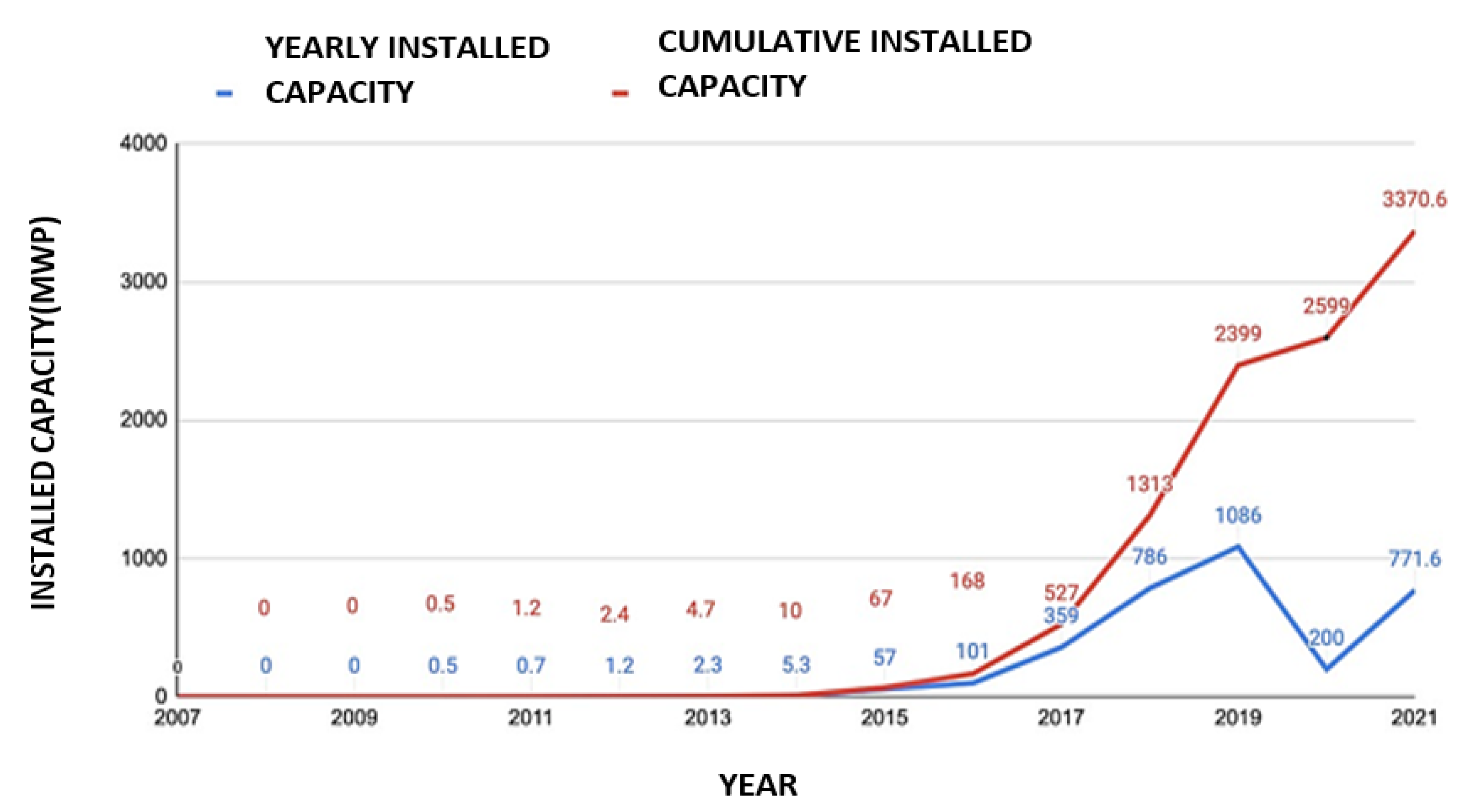
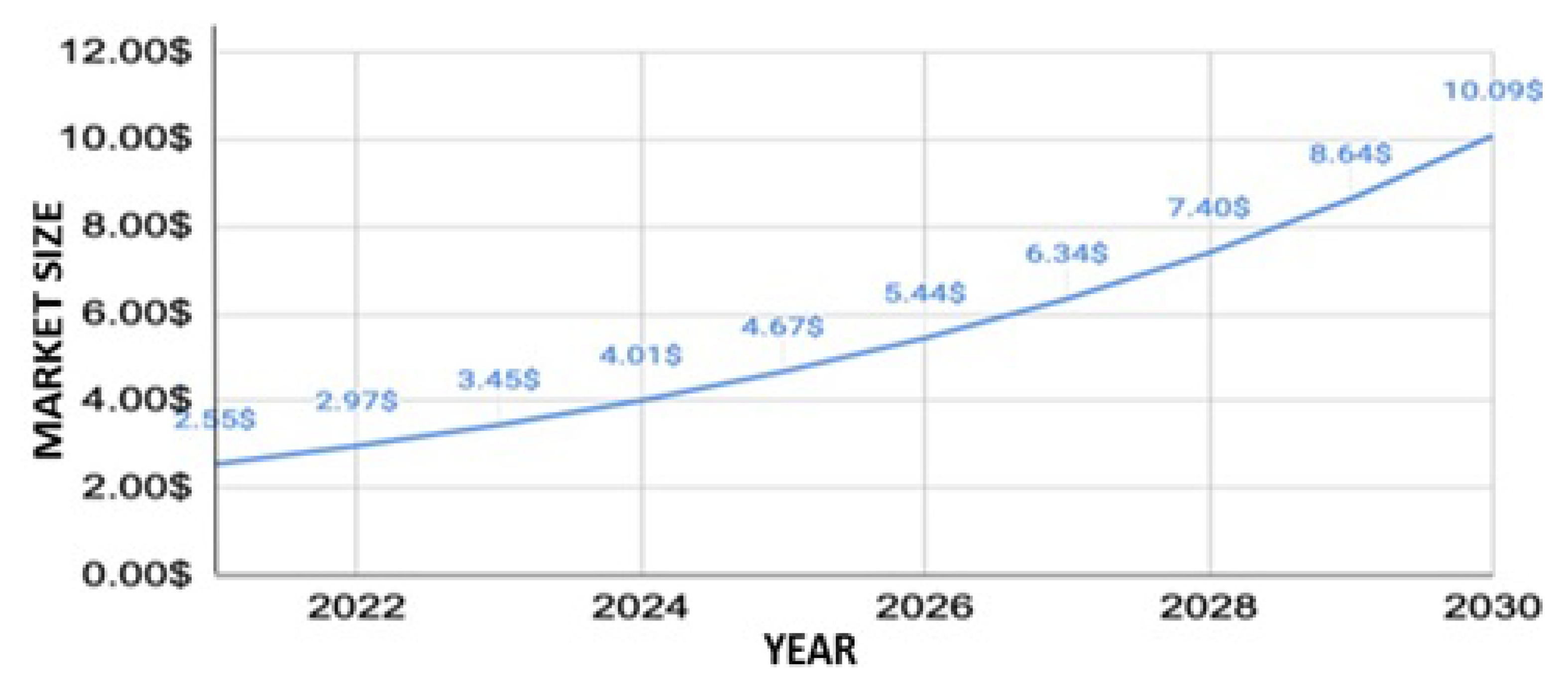
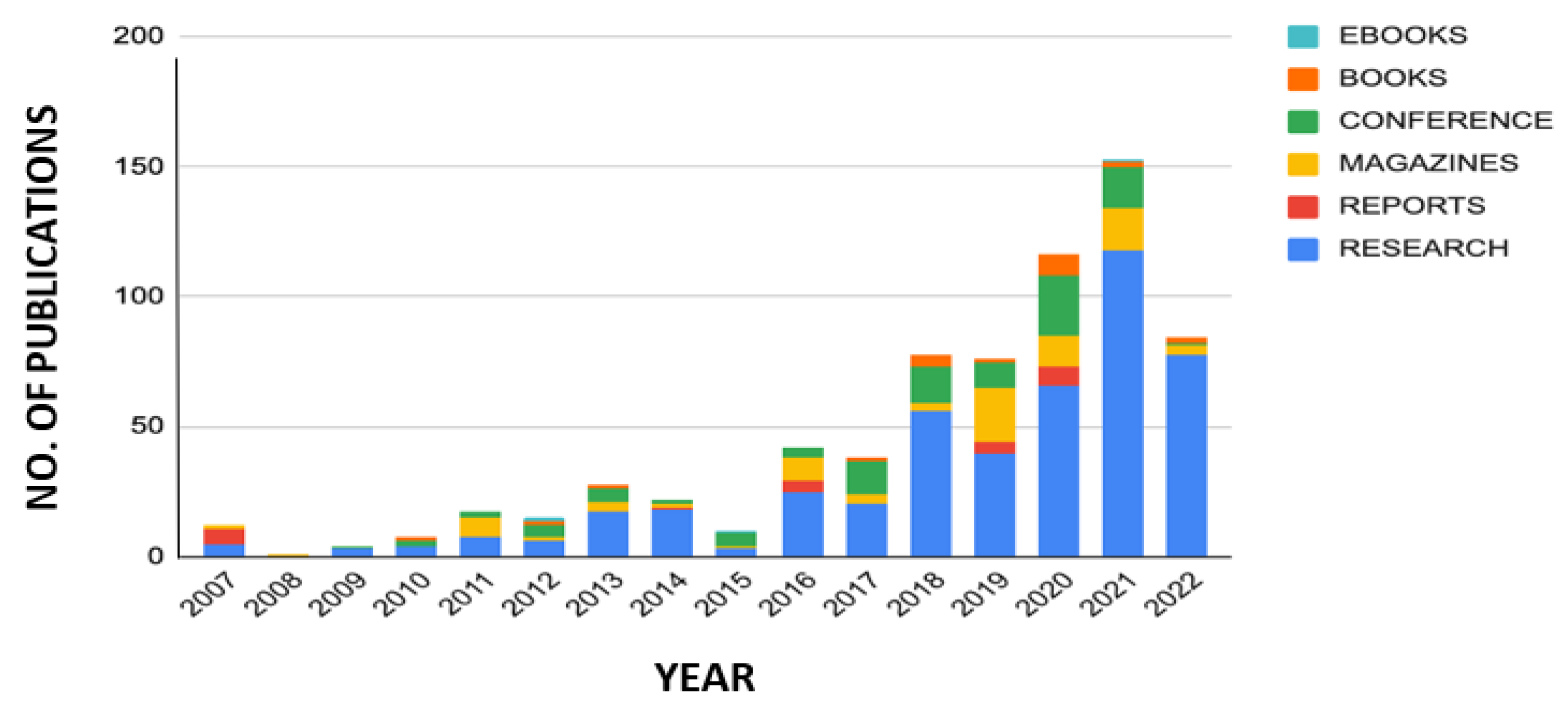


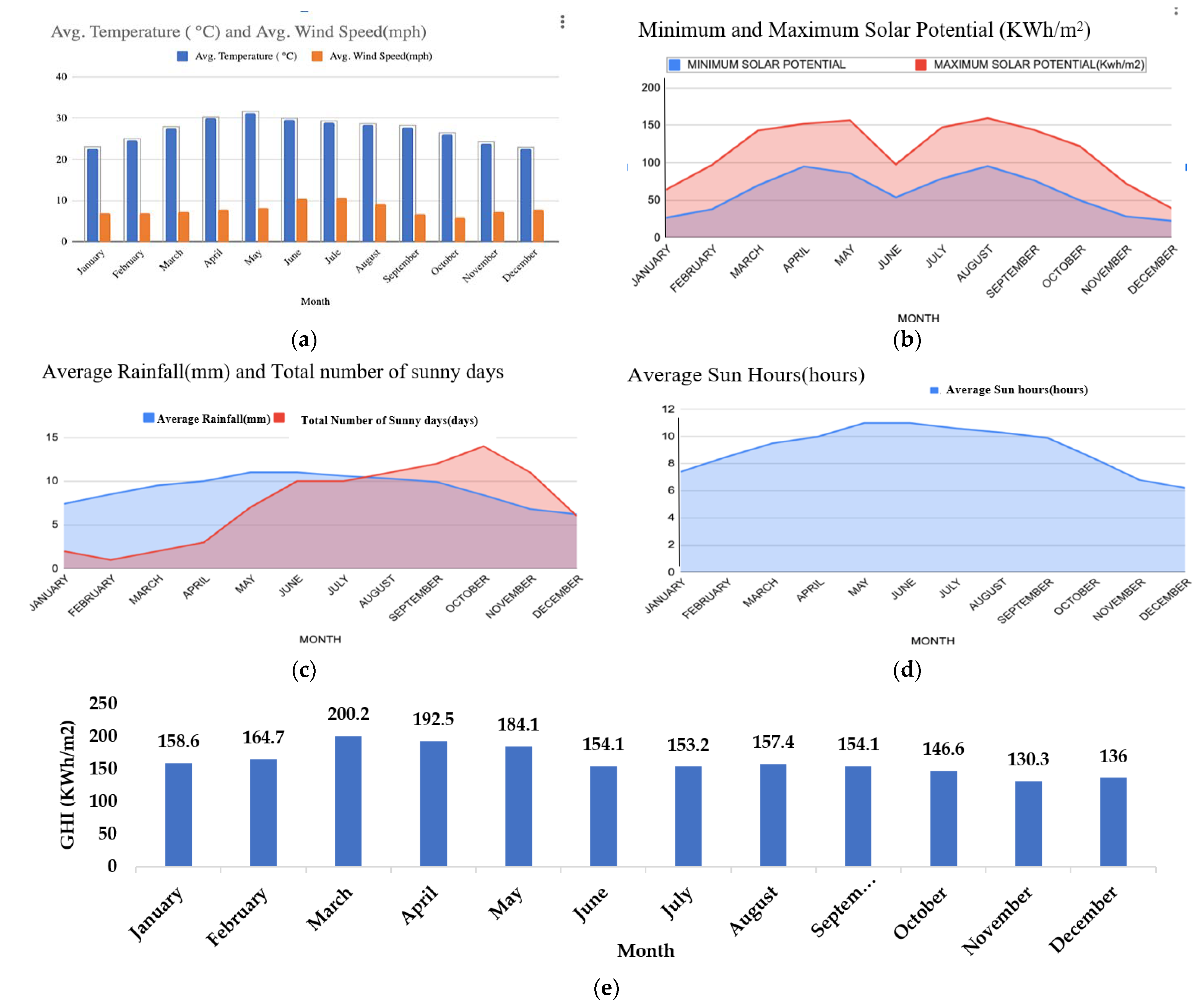
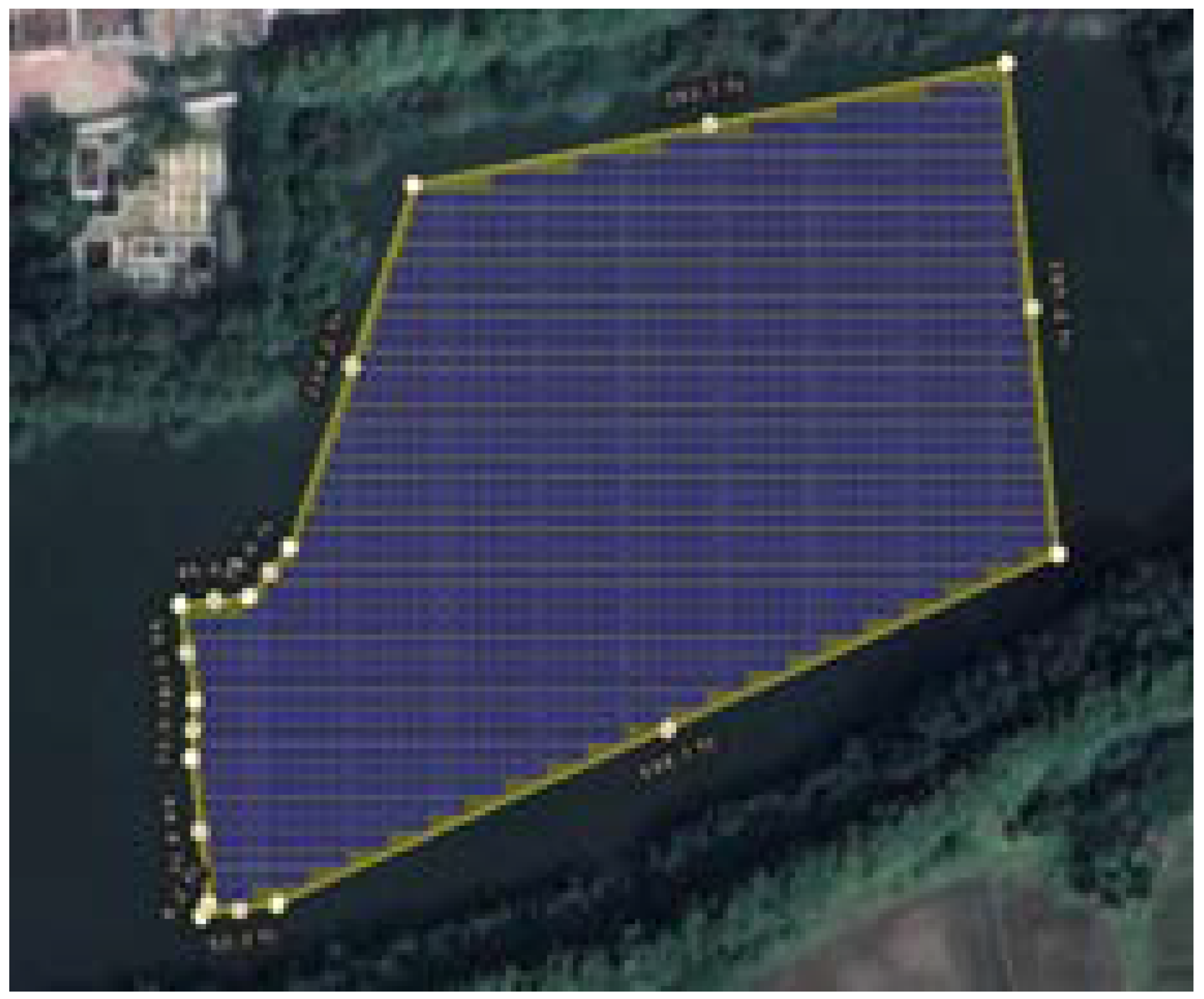
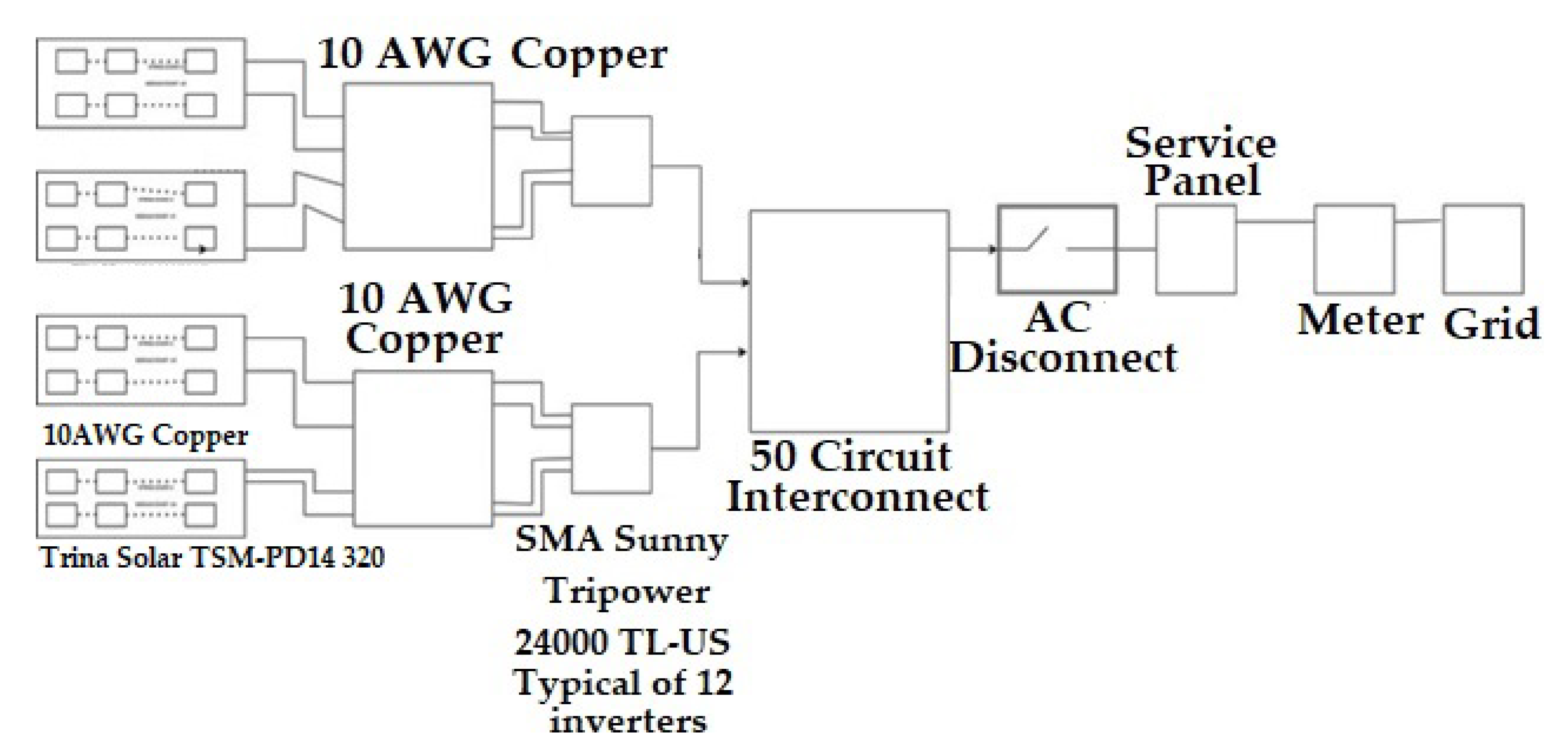
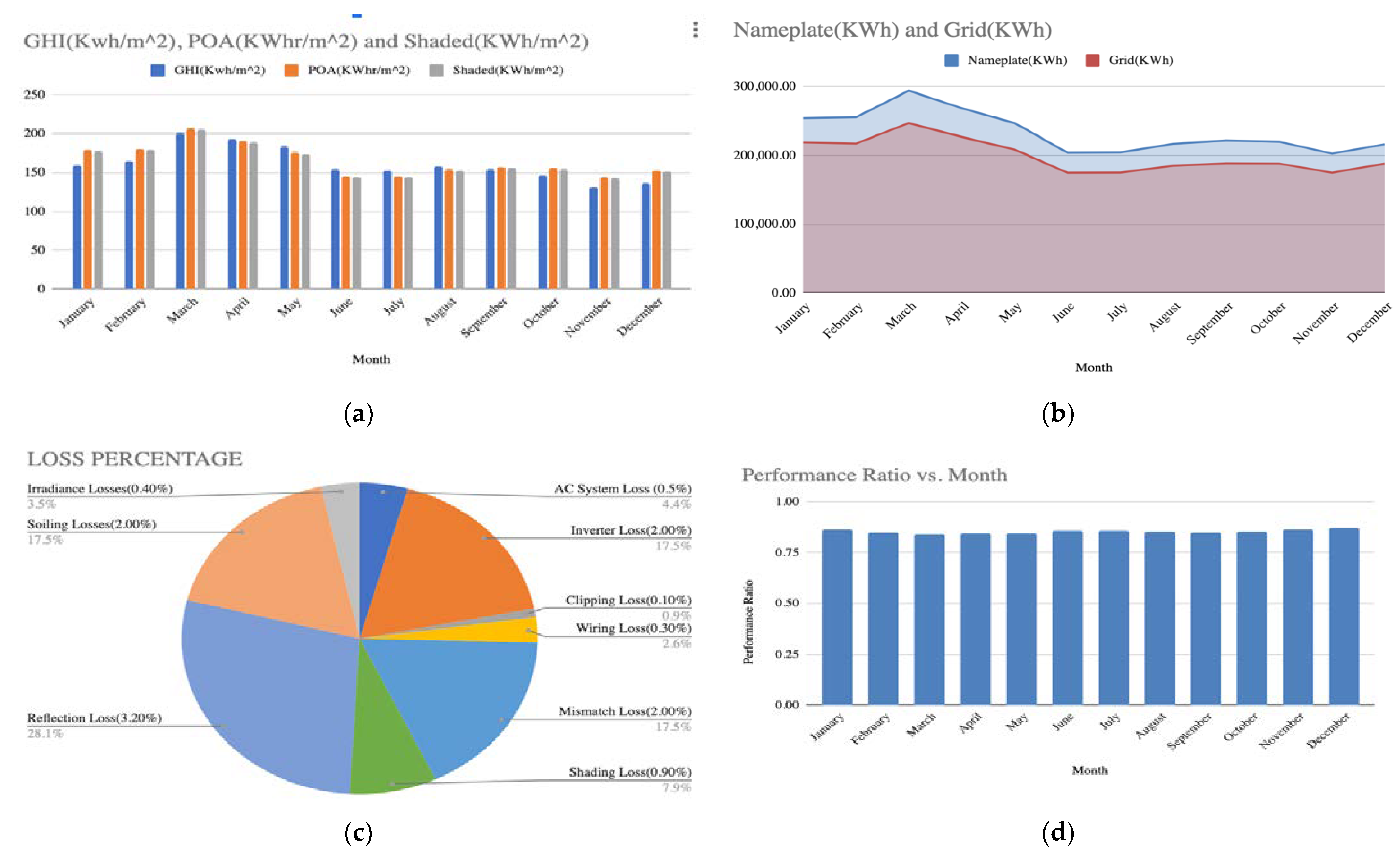
| Item name | Model | Parameter | Value |
|---|---|---|---|
| PV module | Trina Solar TSM-PD14 320 | STC Rating | 320 Wp |
| Vmp | 37.1 V | ||
| Imp | 8.63 A | ||
| Voc | 45.8 V | ||
| Ioc | 9.1 A | ||
| Quantity | 4689 | ||
| Solar inverter | SMA Sunny Tripower 24,000 TL-US | Max AC Power Rating | 24,000 W |
| Max Input Voltage | 1000 V | ||
| Quantity | 50 | ||
| Wires | Wire schedule | Tier | String |
| Wire | 250 × 10 AWG | ||
| Length | 4958 ft |
| Parameters | Battery Capacity (kWh) | Motor Power (kW) | Maximum Speed (km/h) | Maximum Torque (Nm) | Energy Consumption (Wh/km) | CO2 Emission (g/psngr/km) |
|---|---|---|---|---|---|---|
| E-bike (BH27) | 0.28 | 0.25 | 25 | 40 | 7.9 | 16.1 |
| E-scooter (Ather 450X) | 2.61 | 6 | 80 | 26 | 30.7 | 29.8 |
| E-car (Tesla Model 3) | 50 | 336 | 162 | 639 | 151 | 92.4 |
| Parameters | Value | |
|---|---|---|
| Annual distance covered | ||
| Percentage km covered more | ||
| CO2 emissions (g/psngr/km) | ||
| Annual CO2 emissions | ||
| CO2 emissions from plants | Coal based plants | 1000 g/kWh |
| PV based plant | 40 g/kWh | |
| Savings in CO2 emissions | 960 g/unit | |
| Total CO2 emission savings | TCE | |
| Annual emission savings when EV charged from FPVS | Electric bike | −2574.1 |
| Electric scooter | −25.5 | |
| Electric car | 831.2 | |
| Net Zero CO2 emission time period (months) | Electric bike | 25.5 |
| Electric scooter | 12.1 | |
| Electric car | 7.7 | |
| Parameters | Value | |
|---|---|---|
| Energy required | ||
| Percentage energy more required | ||
| Annual CO2 emissions | ||
| Total CO2 emission saving when EV charged from FPVS instead of conventional grid | ||
| Emission savings when FPVS is used to charge EV | Electric bike | −85.16 |
| Electric scooter | −3.28 | |
| Electric car | 525.6 | |
Publisher’s Note: MDPI stays neutral with regard to jurisdictional claims in published maps and institutional affiliations. |
© 2022 by the authors. Licensee MDPI, Basel, Switzerland. This article is an open access article distributed under the terms and conditions of the Creative Commons Attribution (CC BY) license (https://creativecommons.org/licenses/by/4.0/).
Share and Cite
Ramshanker, A.; Chakraborty, S.; Elangovan, D.; Kotb, H.; Aboras, K.M.; Giri, N.C.; Agyekum, E.B. CO2 Emission Analysis for Different Types of Electric Vehicles When Charged from Floating Solar Photovoltaic Systems. Appl. Sci. 2022, 12, 12552. https://doi.org/10.3390/app122412552
Ramshanker A, Chakraborty S, Elangovan D, Kotb H, Aboras KM, Giri NC, Agyekum EB. CO2 Emission Analysis for Different Types of Electric Vehicles When Charged from Floating Solar Photovoltaic Systems. Applied Sciences. 2022; 12(24):12552. https://doi.org/10.3390/app122412552
Chicago/Turabian StyleRamshanker, Abinands, Suprava Chakraborty, Devaraj Elangovan, Hossam Kotb, Kareem M. Aboras, Nimay Chandra Giri, and Ephraim Bonah Agyekum. 2022. "CO2 Emission Analysis for Different Types of Electric Vehicles When Charged from Floating Solar Photovoltaic Systems" Applied Sciences 12, no. 24: 12552. https://doi.org/10.3390/app122412552
APA StyleRamshanker, A., Chakraborty, S., Elangovan, D., Kotb, H., Aboras, K. M., Giri, N. C., & Agyekum, E. B. (2022). CO2 Emission Analysis for Different Types of Electric Vehicles When Charged from Floating Solar Photovoltaic Systems. Applied Sciences, 12(24), 12552. https://doi.org/10.3390/app122412552










